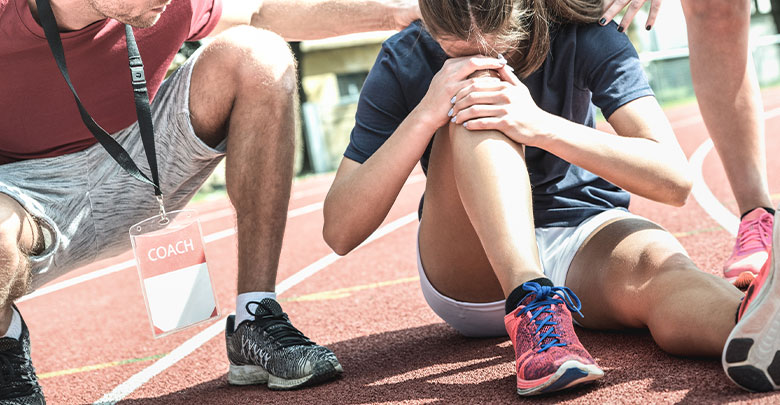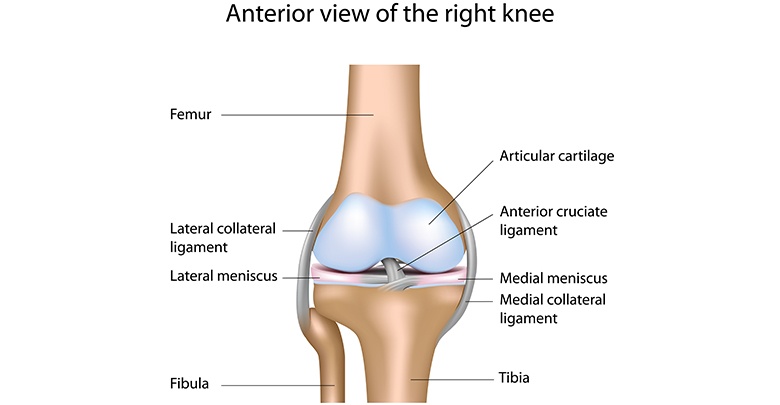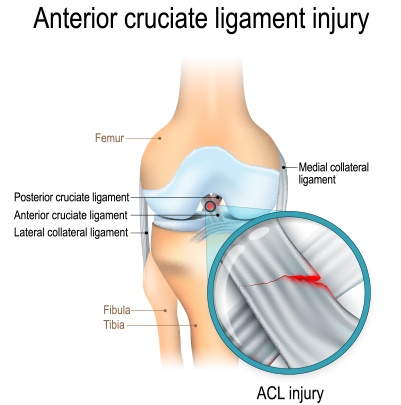
Have you injured your knee? You may be interested to know what the symptoms of an ACL tear are
USE the OMH exclusive code "HEALTH15" to Save 15%Especially if you are a sports person, the thought of an ACL (anterior cruciate ligament) tear probably fills you with dread. Possibly you know someone who has torn their ACL and have been witness to the long and difficult process to return to normal every day function, and hopefully a return to sport? If you have injured your knee, the thought of “Oh no… I hope I have not torn my ACL!” may have popped into your head. Read more to find out the symptoms of ACL tear.
In this article we will explain
- the anatomy of the ACL and what function the ligament performs in your knee
- how the ACL is typically injured
- the symptoms of ACL tear
The anatomy and function of the ACL

The ACL (Anterior Cruciate Ligament) is the ligament deep inside the middle of your knee joint, which runs from the front of the tibia (shin bone) to the back of the femur (the thigh bone). The intact ligament prevents the shin bone from sliding or shearing backwards on the thigh bone, and also provides rotational stability. This means that the ACL is a very important ligament to give your knee the stability it needs to function normally.
There is another cruciate ligament called your Posterior Cruciate Ligament (PCL), which crosses over the ACL. The PCL prevents shearing in the opposite direction, and is less commonly injured.
The ACL ligament is a very strong fibrous band of connective tissue. ACL tears are not uncommon and occur more frequently in sports such as basketball, cheerleading, volleyball, football, netball, and downhill skiing. They also occur 2-4 times more frequently in females compared to males. An ACL tear is the most common cause of a prolonged absence from sport.
How the ACL is typically injured
The latest forensic research by De Frate and his team shows that an ACL is most often torn when landing on a hyperextended (overly straightened) knee.
Previously it has been believed that an ACL was injured due to an inward buckling of the knee causing excessive valgus force on the ACL, or from decelerating suddenly, pivoting on the knee or another player falling across the knee.
Grades of Ligament Injuries
Injuries to any ligament are graded according the extent of the damage to the ligament

Grade 1 sprain: some of the fibres of the ligament are torn, but the ligament is still intact and essentially able to perfrom its stabilising function. The ligament would be slightly stretched, but can heal over time
Grade 2 sprain: more of the ligament fibres are torn. There is more pain and swelling, and the ligament is less able to perform it’s stabilising function. This is also sometimes called a “partial tear”
Grade 3 sprain: all of the ligament fibres are torn. The ligament is unable to stabilise the joint, creating a feeling of instability. Extensive brusing and swelling are seen. This is often called a “complete tear”or “rupture”of the ligament.
The symptoms of ACL tear
- An audible “pop” or a crunching sensation is sometimes heard or felt – especially with a complete tear of the ACL
- A feeling of instability in your knee – especially when bearing weight on the knee. Most often immediately following an ACL injury, it is physically impossible to put any weight on the knee.
- Rapid and extreme swelling – due to the fact that the ACL lies inside the joint capsule, a torn ACL most often causes very noticeable swelling within a couple of hours and up to 24 hours after the injury. If your knee looks like it swallowed a grapefruit then it may be an ACL tear! Occasionally swelling is minimal or delayed.
- A loss of range of movement , partuclarly knee extension – you will probably not be able to bend and especially not be able to straighten your knee fully
- Pain and bruising – initially it is extremely painful. Also due to the tissue damage you may feel pain all over the knee. It is very hard to pinpoint the pain in the initial phase following an injury.
Diagnosis of an ACL tear
If you have sustained an injury to your knee and you suspect you may have torn your ACL you have to see a doctor, preferably an orthopedic surgeon. The doctor will examine your knee and ask you how the injury happened. There are specific ligament stability tests to check the ACL. These are the Lachman Test, the Pivot Shift Test, and the Anterior Drawer Test. Sometimes if the knee is too swolen, it is difficult to get an accurate diagnosis.
Your doctor will need to order further examinations, which usually include
- X-rays – to check for signs of ACL tear and to see if there are any bony injuries or fractures
- MRI scan – this shows the “soft tissue structures” such as the actual ligaments, the meniscal structures, and tendons
- Ultrasound scan – this is for more superficial injuries, but is less expensive than an MRI and can show whether there is a collateral ligament injury
ACL tears can also occur together with damage to other structures of the knee joint
- the meniscus (often the medial meniscus)
- the medial collateral ligament
- an avulsion fracture – where a small piece of bone is pulled away by the ligament tearing
- less commonly other structures of the knee may be injured too
If you have torn your ACL
Depending on what the orthopedic surgeon finds, the doctor would then discuss your treatment options with you. Initially the doctor would often recommend rest and pre-habilitation with a physiotherapist in order to let the knee settle down, to see how you feel and how you cope with any instability. They would then later discuss and decide with you, whether surgery is best for you, or whether a conservative approach is the preferred option.
Helpful resources
We have put together this great video showing a model of the knee joint, and where exactly the ACL lies. It also gives you an overview of how the ACL is injured, recovery time and safe exercises to do following an ACL injury. You can also download a free PDF of the exercises to do following an ACL injury – either pre-operatively, or post operatively of if you are following a conservative management program.
References
- Brukner & Khan, Brukner & Khan’s Clinical Sports Medicine: Injuries, Voume 1, 2017, McGraw Hill Australia
- 2. Cereatti, Andrea & Ripani, F. & Margheritini, Fabrizio. (2011). Pathophysiology of Ligament Injuries. 10.1007/978-88-470-1702-3_4.
- Frank H. Netter, Atlas of Human Anatomy, International Edition, Elsevier Health Sciences, London
- Owusu-Akyaw KA, Kim SY, Spritzer CE, Collins AT, Englander ZA, Utturkar GM, Garrett WE, DeFrate LE. Determination of the Position of the Knee at the Time of an Anterior Cruciate Ligament Rupture for Male Versus Female Patients by an Analysis of Bone Bruises. Am J Sports Med. 2018 Jun;46(7):1559-1565. doi: 10.1177/0363546518764681. Epub 2018 Apr 18. PubMed PMID: 29667852; PubMed Central PMCID: PMC5976536.